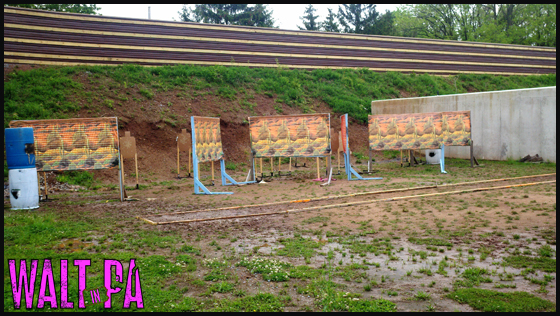
After the morning shooter briefing finished, squadding commenced. A small group of shooters, myself among them, stood off to the side, muttering to ourself “Anyplace but squad one…. anyplace but squad one…. anyplace but squad one….”
I hadn’t seen Stage 1 for myself (where Squad 1 would be starting their day) but a couple of people made mention that a portion of the shooting area was underwater. My hope was that a squad, or two, or three, would run through the stage and track out some of the water before I had to shoot it.
It turns out that two squads ran the stage before my squad arrived. Based on what I heard from shooters that saw the before and after, a lot of water was tracked out but one portion of the stage was kind of slick and very muddy. With no other choice, I sloshed over to the start position and began my walk through.
The Plan:
When it comes to USPSA, I enjoy variety and a challenging stage. The one stage type that I enjoy least, though, is the memory stage. It is sort of like that memory game, Simon, with the flashing lights. At first it is easy to keep track of what buttons to push and in what sequence to push them. The deeper you got into the game, the more confusing it became. This USPSA stage was sort of like that.
Due to the layout of targets, shooters might see the same target from a variety of positions. Some targets might be engaged multiple times, others might not be engaged at all because shooters may think they already engaged them.
My plan of attack was to mentally break apart the stage. I would pick out a series of targets as my first array. I would do the same for another bunch of targets and call them array two. So on and so forth for arrays three and four. Each array would require one magazine, which would help me track targets. If my gun ran dry, I engaged too many and had a problem. If I didn’t count enough rounds, I missed something and had a problem.
I would start on the left side of the shooting area and work my way to the right. Shooting whatever targets I could see, I would move a little and start the process over, keeping a firm mental imagine of what made up the array that I was shooting. After an array was finished, I would make a much larger movement and reload, starting the process over for the new array.
The Execution:
My method of separating targets into arrays wasn’t the most popular choice, but it got the job done. I didn’t miss or overlap targets. My only issue came in the form of my movement. Generally when I move a long distance, I take my support hand off f my gun. I found myself doing that here, with small movements, and it felt awkward.
My small movements seemed very timid. I suppose that was the point but I think that I could have been more agressive. Watching the Master Class Shooters in my squad, they were explosive all the time. They were fast to get into position, made well placed shots, then exploded out of position to move to the next. Even in the mud, these guys were fast and made me feel like a toddler learning to walk.
The Results
My slow and steady pace worked out fairly well for me. I scored 25 A’s, 5 C’s, and 2 D’s, earning me 142 of a possible 160 points. My two D Zone hits were on the last target that I shot. I got lazy and didn’t move left to get a better shot around the barrel. Instead, I tried to squeak two shots into the sliver of an A Zone and it didn’t work out as I hoped. My time was 39.38 Seconds with a Hit Factor of 3.5598. I scored 89% of the available points on the stage.
Recent Posts
The Price of Rushing: A Winter Riding Story & Four Years of YouTube Friendship
You know those moments when you do something that isn't exactly catastrophically stupid, but just stupid enough to make you shake your head at yourself? Yeah, we've all been there, and today I'm...
Finding Joy in Unexpected Places: A Memorable Motorcycle Ride to Remember
As we roll into 2025, I've been reflecting on the rides that made 2024 special. While the year didn't provide as many opportunities to hit the road as I'd hoped, one particular adventure stands out...
